Healthcare and Wellness Programs
VerifiedAdded on 2023/06/10
|12
|2907
|268
AI Summary
This paper discusses the components and programs involved in workplace mental health and wellness programs. It also includes the development of a workplace mental health program and its cultural component.
Contribute Materials
Your contribution can guide someone’s learning journey. Share your
documents today.
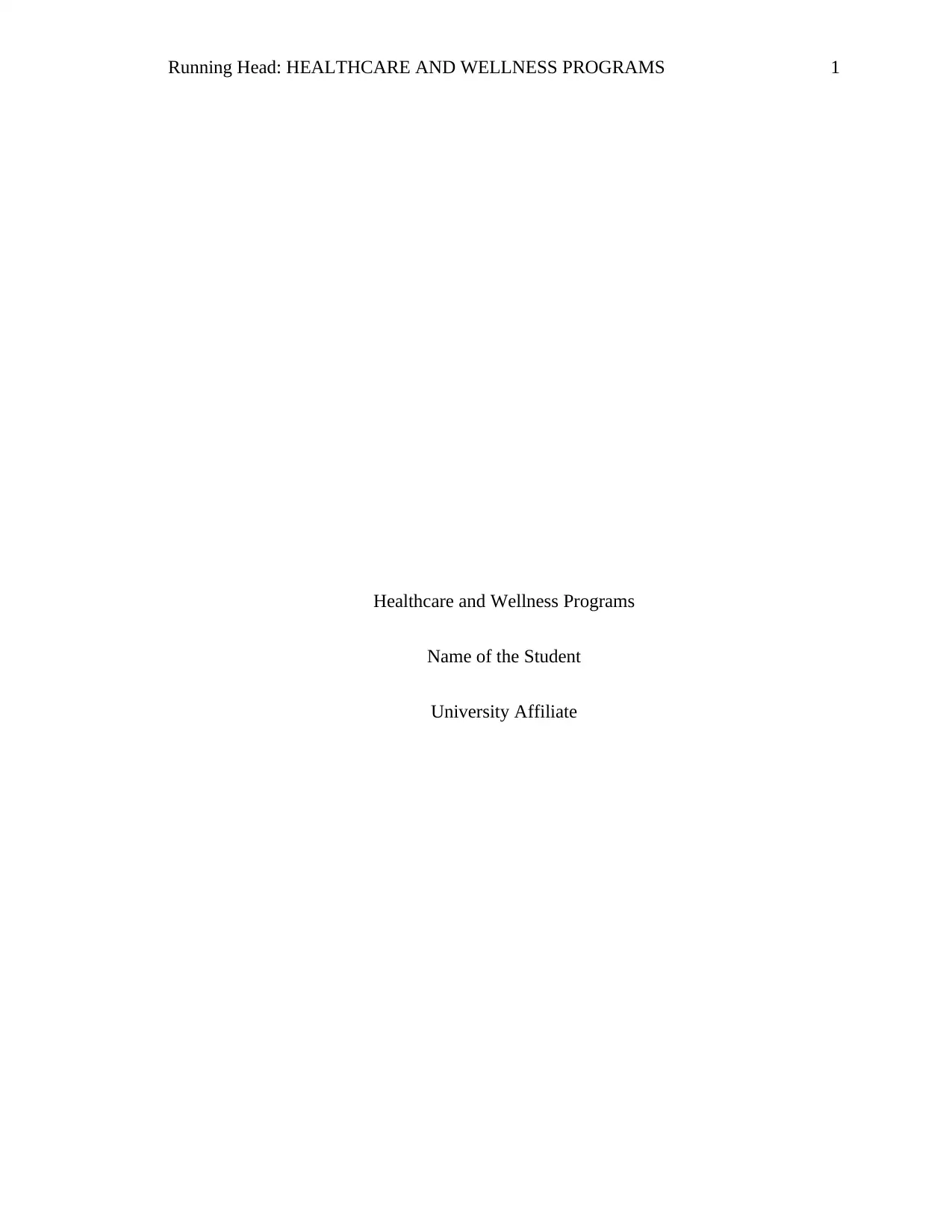
Running Head: HEALTHCARE AND WELLNESS PROGRAMS 1
Healthcare and Wellness Programs
Name of the Student
University Affiliate
Healthcare and Wellness Programs
Name of the Student
University Affiliate
Secure Best Marks with AI Grader
Need help grading? Try our AI Grader for instant feedback on your assignments.
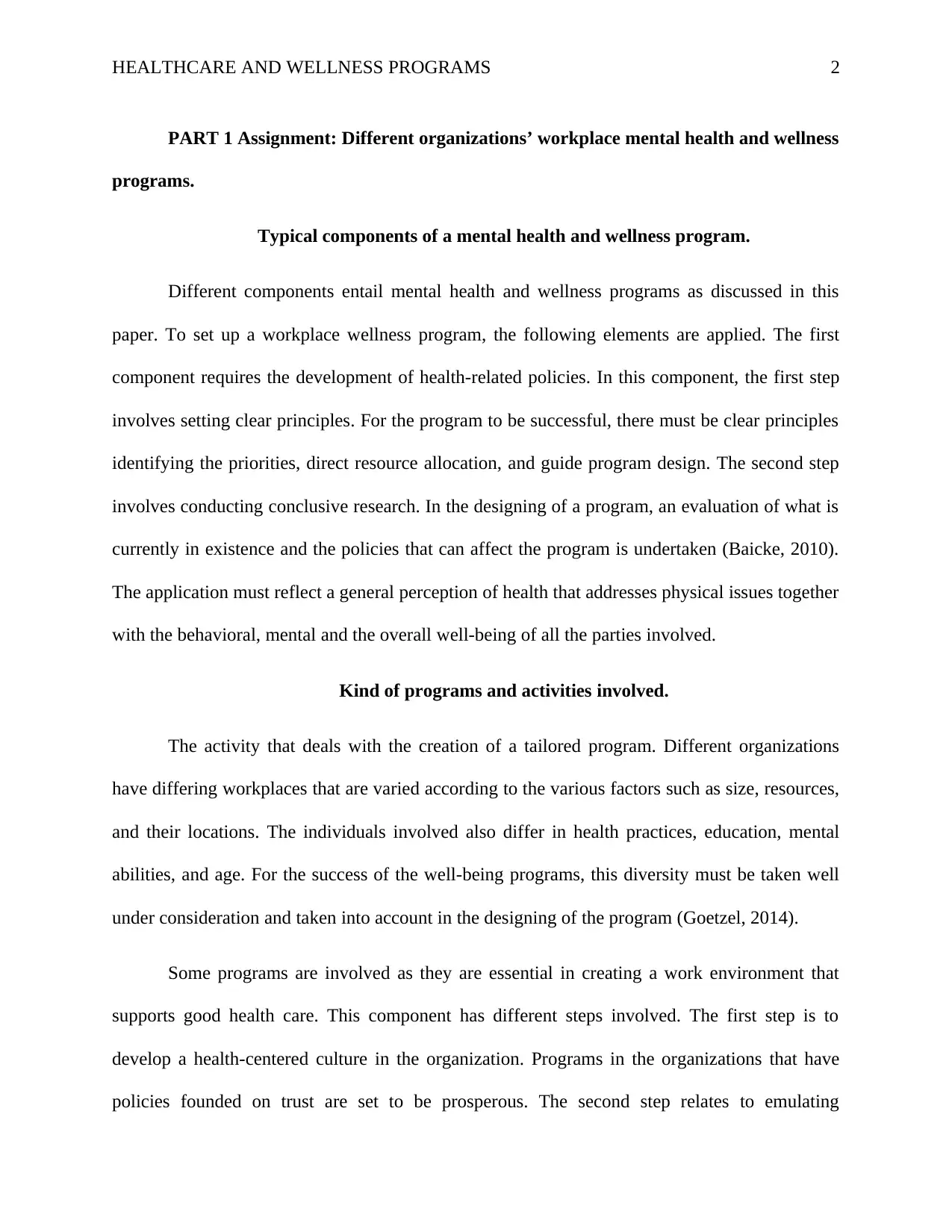
HEALTHCARE AND WELLNESS PROGRAMS 2
PART 1 Assignment: Different organizations’ workplace mental health and wellness
programs.
Typical components of a mental health and wellness program.
Different components entail mental health and wellness programs as discussed in this
paper. To set up a workplace wellness program, the following elements are applied. The first
component requires the development of health-related policies. In this component, the first step
involves setting clear principles. For the program to be successful, there must be clear principles
identifying the priorities, direct resource allocation, and guide program design. The second step
involves conducting conclusive research. In the designing of a program, an evaluation of what is
currently in existence and the policies that can affect the program is undertaken (Baicke, 2010).
The application must reflect a general perception of health that addresses physical issues together
with the behavioral, mental and the overall well-being of all the parties involved.
Kind of programs and activities involved.
The activity that deals with the creation of a tailored program. Different organizations
have differing workplaces that are varied according to the various factors such as size, resources,
and their locations. The individuals involved also differ in health practices, education, mental
abilities, and age. For the success of the well-being programs, this diversity must be taken well
under consideration and taken into account in the designing of the program (Goetzel, 2014).
Some programs are involved as they are essential in creating a work environment that
supports good health care. This component has different steps involved. The first step is to
develop a health-centered culture in the organization. Programs in the organizations that have
policies founded on trust are set to be prosperous. The second step relates to emulating
PART 1 Assignment: Different organizations’ workplace mental health and wellness
programs.
Typical components of a mental health and wellness program.
Different components entail mental health and wellness programs as discussed in this
paper. To set up a workplace wellness program, the following elements are applied. The first
component requires the development of health-related policies. In this component, the first step
involves setting clear principles. For the program to be successful, there must be clear principles
identifying the priorities, direct resource allocation, and guide program design. The second step
involves conducting conclusive research. In the designing of a program, an evaluation of what is
currently in existence and the policies that can affect the program is undertaken (Baicke, 2010).
The application must reflect a general perception of health that addresses physical issues together
with the behavioral, mental and the overall well-being of all the parties involved.
Kind of programs and activities involved.
The activity that deals with the creation of a tailored program. Different organizations
have differing workplaces that are varied according to the various factors such as size, resources,
and their locations. The individuals involved also differ in health practices, education, mental
abilities, and age. For the success of the well-being programs, this diversity must be taken well
under consideration and taken into account in the designing of the program (Goetzel, 2014).
Some programs are involved as they are essential in creating a work environment that
supports good health care. This component has different steps involved. The first step is to
develop a health-centered culture in the organization. Programs in the organizations that have
policies founded on trust are set to be prosperous. The second step relates to emulating
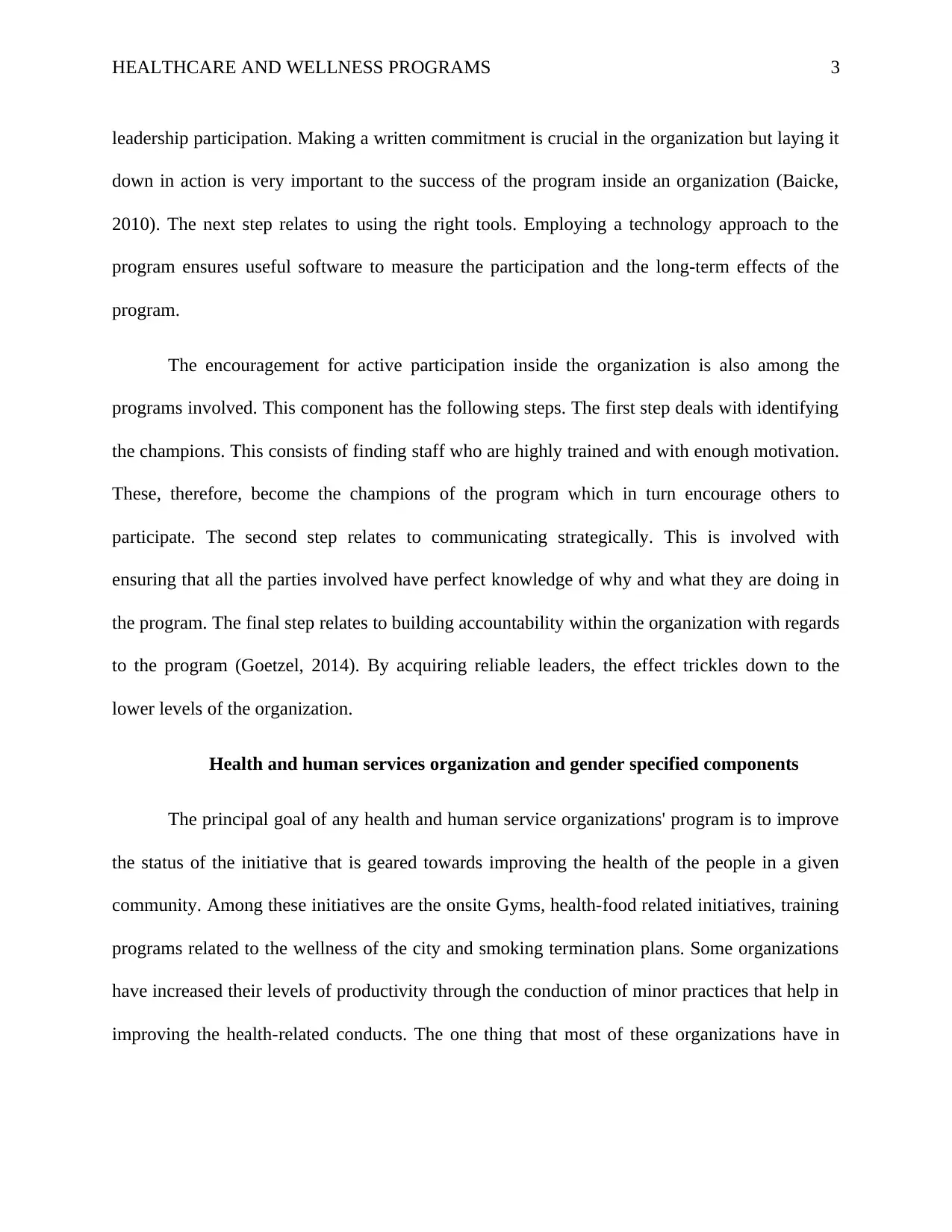
HEALTHCARE AND WELLNESS PROGRAMS 3
leadership participation. Making a written commitment is crucial in the organization but laying it
down in action is very important to the success of the program inside an organization (Baicke,
2010). The next step relates to using the right tools. Employing a technology approach to the
program ensures useful software to measure the participation and the long-term effects of the
program.
The encouragement for active participation inside the organization is also among the
programs involved. This component has the following steps. The first step deals with identifying
the champions. This consists of finding staff who are highly trained and with enough motivation.
These, therefore, become the champions of the program which in turn encourage others to
participate. The second step relates to communicating strategically. This is involved with
ensuring that all the parties involved have perfect knowledge of why and what they are doing in
the program. The final step relates to building accountability within the organization with regards
to the program (Goetzel, 2014). By acquiring reliable leaders, the effect trickles down to the
lower levels of the organization.
Health and human services organization and gender specified components
The principal goal of any health and human service organizations' program is to improve
the status of the initiative that is geared towards improving the health of the people in a given
community. Among these initiatives are the onsite Gyms, health-food related initiatives, training
programs related to the wellness of the city and smoking termination plans. Some organizations
have increased their levels of productivity through the conduction of minor practices that help in
improving the health-related conducts. The one thing that most of these organizations have in
leadership participation. Making a written commitment is crucial in the organization but laying it
down in action is very important to the success of the program inside an organization (Baicke,
2010). The next step relates to using the right tools. Employing a technology approach to the
program ensures useful software to measure the participation and the long-term effects of the
program.
The encouragement for active participation inside the organization is also among the
programs involved. This component has the following steps. The first step deals with identifying
the champions. This consists of finding staff who are highly trained and with enough motivation.
These, therefore, become the champions of the program which in turn encourage others to
participate. The second step relates to communicating strategically. This is involved with
ensuring that all the parties involved have perfect knowledge of why and what they are doing in
the program. The final step relates to building accountability within the organization with regards
to the program (Goetzel, 2014). By acquiring reliable leaders, the effect trickles down to the
lower levels of the organization.
Health and human services organization and gender specified components
The principal goal of any health and human service organizations' program is to improve
the status of the initiative that is geared towards improving the health of the people in a given
community. Among these initiatives are the onsite Gyms, health-food related initiatives, training
programs related to the wellness of the city and smoking termination plans. Some organizations
have increased their levels of productivity through the conduction of minor practices that help in
improving the health-related conducts. The one thing that most of these organizations have in
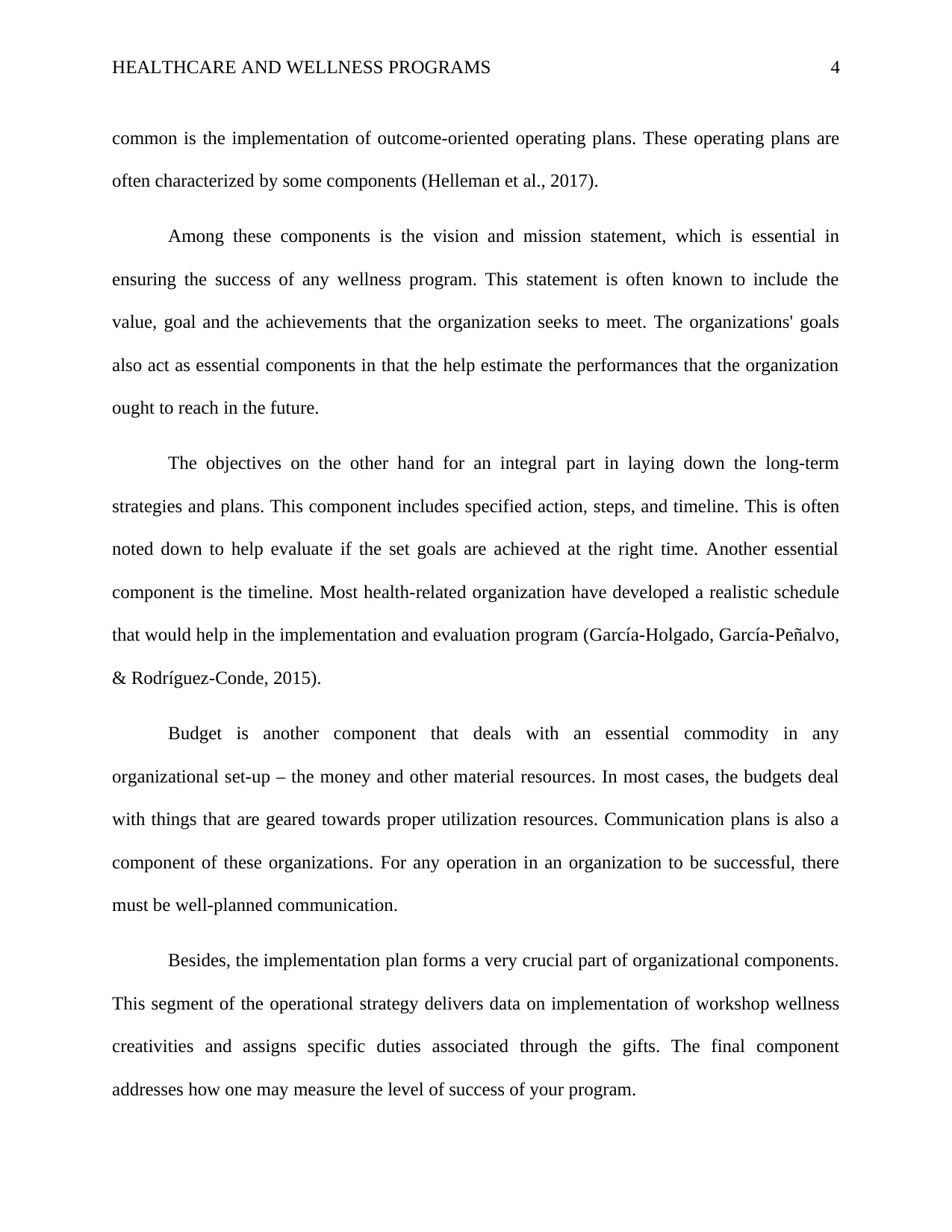
HEALTHCARE AND WELLNESS PROGRAMS 4
common is the implementation of outcome-oriented operating plans. These operating plans are
often characterized by some components (Helleman et al., 2017).
Among these components is the vision and mission statement, which is essential in
ensuring the success of any wellness program. This statement is often known to include the
value, goal and the achievements that the organization seeks to meet. The organizations' goals
also act as essential components in that the help estimate the performances that the organization
ought to reach in the future.
The objectives on the other hand for an integral part in laying down the long-term
strategies and plans. This component includes specified action, steps, and timeline. This is often
noted down to help evaluate if the set goals are achieved at the right time. Another essential
component is the timeline. Most health-related organization have developed a realistic schedule
that would help in the implementation and evaluation program (García-Holgado, García-Peñalvo,
& Rodríguez-Conde, 2015).
Budget is another component that deals with an essential commodity in any
organizational set-up – the money and other material resources. In most cases, the budgets deal
with things that are geared towards proper utilization resources. Communication plans is also a
component of these organizations. For any operation in an organization to be successful, there
must be well-planned communication.
Besides, the implementation plan forms a very crucial part of organizational components.
This segment of the operational strategy delivers data on implementation of workshop wellness
creativities and assigns specific duties associated through the gifts. The final component
addresses how one may measure the level of success of your program.
common is the implementation of outcome-oriented operating plans. These operating plans are
often characterized by some components (Helleman et al., 2017).
Among these components is the vision and mission statement, which is essential in
ensuring the success of any wellness program. This statement is often known to include the
value, goal and the achievements that the organization seeks to meet. The organizations' goals
also act as essential components in that the help estimate the performances that the organization
ought to reach in the future.
The objectives on the other hand for an integral part in laying down the long-term
strategies and plans. This component includes specified action, steps, and timeline. This is often
noted down to help evaluate if the set goals are achieved at the right time. Another essential
component is the timeline. Most health-related organization have developed a realistic schedule
that would help in the implementation and evaluation program (García-Holgado, García-Peñalvo,
& Rodríguez-Conde, 2015).
Budget is another component that deals with an essential commodity in any
organizational set-up – the money and other material resources. In most cases, the budgets deal
with things that are geared towards proper utilization resources. Communication plans is also a
component of these organizations. For any operation in an organization to be successful, there
must be well-planned communication.
Besides, the implementation plan forms a very crucial part of organizational components.
This segment of the operational strategy delivers data on implementation of workshop wellness
creativities and assigns specific duties associated through the gifts. The final component
addresses how one may measure the level of success of your program.
Secure Best Marks with AI Grader
Need help grading? Try our AI Grader for instant feedback on your assignments.
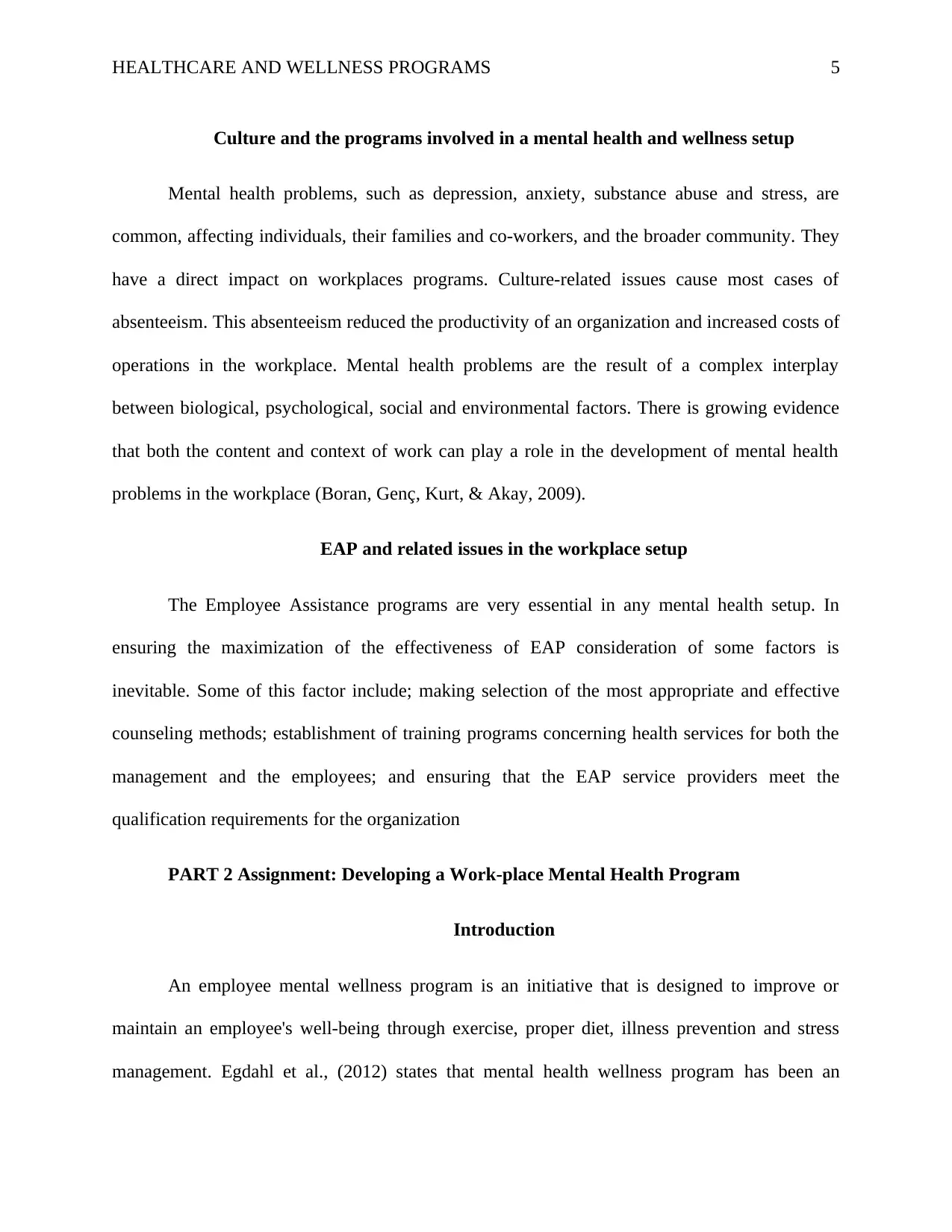
HEALTHCARE AND WELLNESS PROGRAMS 5
Culture and the programs involved in a mental health and wellness setup
Mental health problems, such as depression, anxiety, substance abuse and stress, are
common, affecting individuals, their families and co-workers, and the broader community. They
have a direct impact on workplaces programs. Culture-related issues cause most cases of
absenteeism. This absenteeism reduced the productivity of an organization and increased costs of
operations in the workplace. Mental health problems are the result of a complex interplay
between biological, psychological, social and environmental factors. There is growing evidence
that both the content and context of work can play a role in the development of mental health
problems in the workplace (Boran, Genç, Kurt, & Akay, 2009).
EAP and related issues in the workplace setup
The Employee Assistance programs are very essential in any mental health setup. In
ensuring the maximization of the effectiveness of EAP consideration of some factors is
inevitable. Some of this factor include; making selection of the most appropriate and effective
counseling methods; establishment of training programs concerning health services for both the
management and the employees; and ensuring that the EAP service providers meet the
qualification requirements for the organization
PART 2 Assignment: Developing a Work-place Mental Health Program
Introduction
An employee mental wellness program is an initiative that is designed to improve or
maintain an employee's well-being through exercise, proper diet, illness prevention and stress
management. Egdahl et al., (2012) states that mental health wellness program has been an
Culture and the programs involved in a mental health and wellness setup
Mental health problems, such as depression, anxiety, substance abuse and stress, are
common, affecting individuals, their families and co-workers, and the broader community. They
have a direct impact on workplaces programs. Culture-related issues cause most cases of
absenteeism. This absenteeism reduced the productivity of an organization and increased costs of
operations in the workplace. Mental health problems are the result of a complex interplay
between biological, psychological, social and environmental factors. There is growing evidence
that both the content and context of work can play a role in the development of mental health
problems in the workplace (Boran, Genç, Kurt, & Akay, 2009).
EAP and related issues in the workplace setup
The Employee Assistance programs are very essential in any mental health setup. In
ensuring the maximization of the effectiveness of EAP consideration of some factors is
inevitable. Some of this factor include; making selection of the most appropriate and effective
counseling methods; establishment of training programs concerning health services for both the
management and the employees; and ensuring that the EAP service providers meet the
qualification requirements for the organization
PART 2 Assignment: Developing a Work-place Mental Health Program
Introduction
An employee mental wellness program is an initiative that is designed to improve or
maintain an employee's well-being through exercise, proper diet, illness prevention and stress
management. Egdahl et al., (2012) states that mental health wellness program has been an
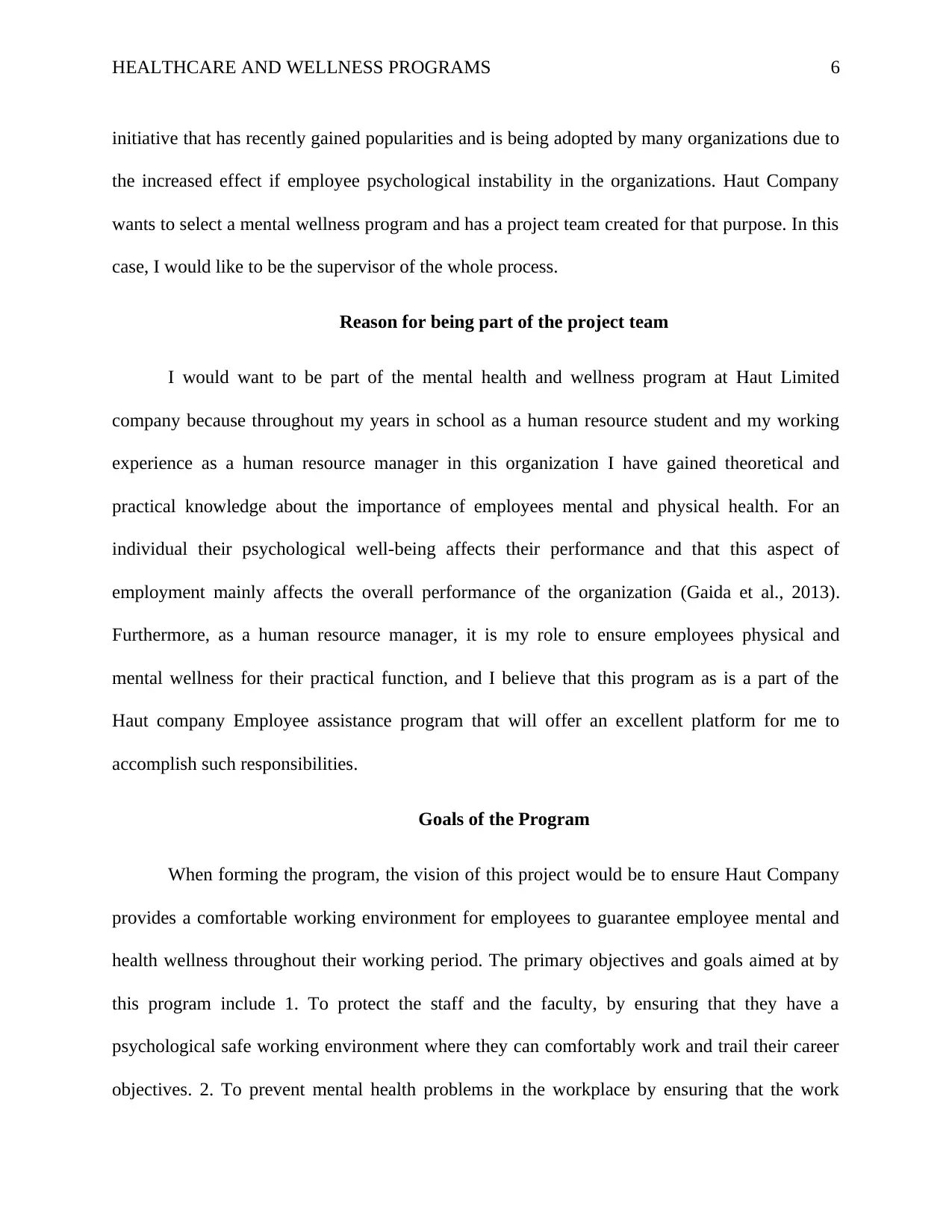
HEALTHCARE AND WELLNESS PROGRAMS 6
initiative that has recently gained popularities and is being adopted by many organizations due to
the increased effect if employee psychological instability in the organizations. Haut Company
wants to select a mental wellness program and has a project team created for that purpose. In this
case, I would like to be the supervisor of the whole process.
Reason for being part of the project team
I would want to be part of the mental health and wellness program at Haut Limited
company because throughout my years in school as a human resource student and my working
experience as a human resource manager in this organization I have gained theoretical and
practical knowledge about the importance of employees mental and physical health. For an
individual their psychological well-being affects their performance and that this aspect of
employment mainly affects the overall performance of the organization (Gaida et al., 2013).
Furthermore, as a human resource manager, it is my role to ensure employees physical and
mental wellness for their practical function, and I believe that this program as is a part of the
Haut company Employee assistance program that will offer an excellent platform for me to
accomplish such responsibilities.
Goals of the Program
When forming the program, the vision of this project would be to ensure Haut Company
provides a comfortable working environment for employees to guarantee employee mental and
health wellness throughout their working period. The primary objectives and goals aimed at by
this program include 1. To protect the staff and the faculty, by ensuring that they have a
psychological safe working environment where they can comfortably work and trail their career
objectives. 2. To prevent mental health problems in the workplace by ensuring that the work
initiative that has recently gained popularities and is being adopted by many organizations due to
the increased effect if employee psychological instability in the organizations. Haut Company
wants to select a mental wellness program and has a project team created for that purpose. In this
case, I would like to be the supervisor of the whole process.
Reason for being part of the project team
I would want to be part of the mental health and wellness program at Haut Limited
company because throughout my years in school as a human resource student and my working
experience as a human resource manager in this organization I have gained theoretical and
practical knowledge about the importance of employees mental and physical health. For an
individual their psychological well-being affects their performance and that this aspect of
employment mainly affects the overall performance of the organization (Gaida et al., 2013).
Furthermore, as a human resource manager, it is my role to ensure employees physical and
mental wellness for their practical function, and I believe that this program as is a part of the
Haut company Employee assistance program that will offer an excellent platform for me to
accomplish such responsibilities.
Goals of the Program
When forming the program, the vision of this project would be to ensure Haut Company
provides a comfortable working environment for employees to guarantee employee mental and
health wellness throughout their working period. The primary objectives and goals aimed at by
this program include 1. To protect the staff and the faculty, by ensuring that they have a
psychological safe working environment where they can comfortably work and trail their career
objectives. 2. To prevent mental health problems in the workplace by ensuring that the work
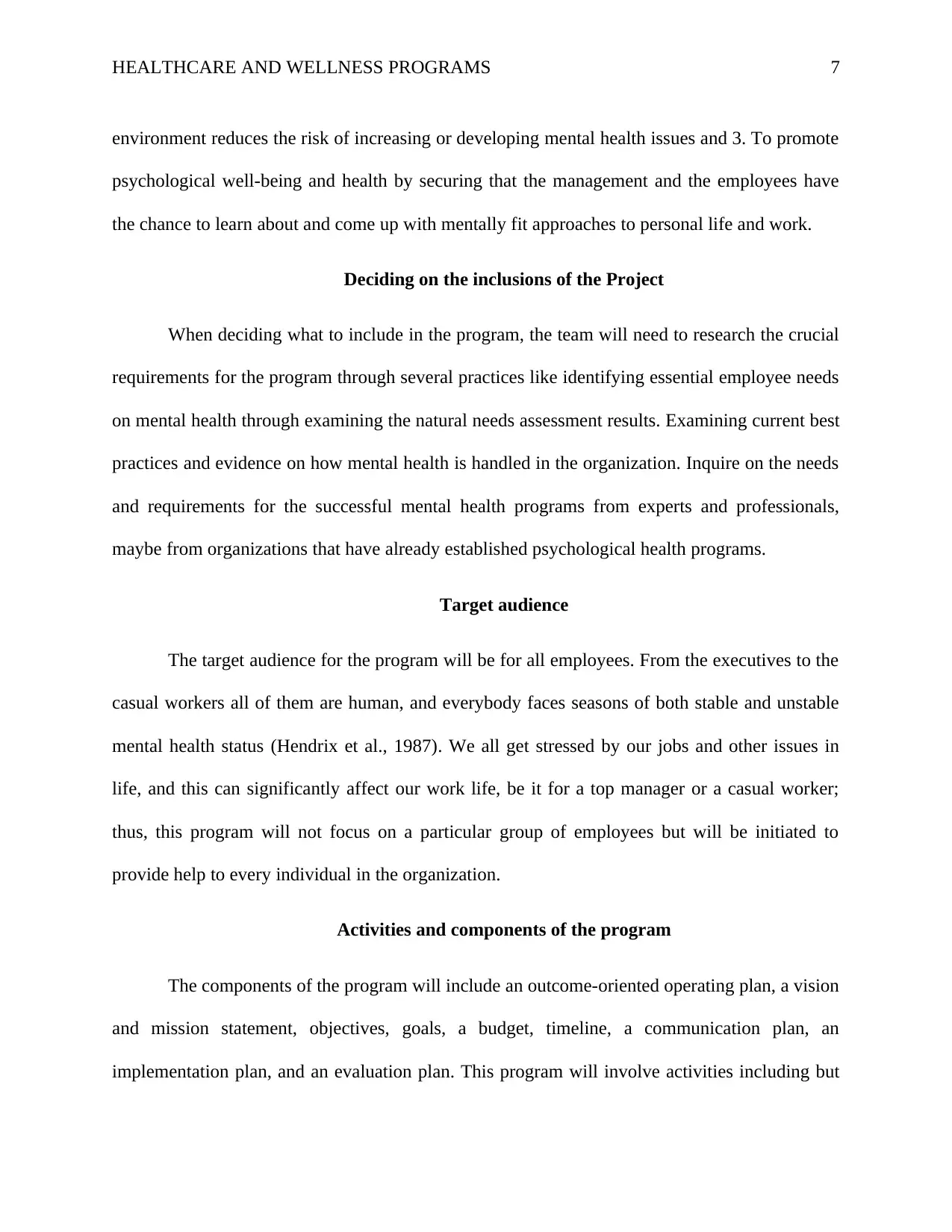
HEALTHCARE AND WELLNESS PROGRAMS 7
environment reduces the risk of increasing or developing mental health issues and 3. To promote
psychological well-being and health by securing that the management and the employees have
the chance to learn about and come up with mentally fit approaches to personal life and work.
Deciding on the inclusions of the Project
When deciding what to include in the program, the team will need to research the crucial
requirements for the program through several practices like identifying essential employee needs
on mental health through examining the natural needs assessment results. Examining current best
practices and evidence on how mental health is handled in the organization. Inquire on the needs
and requirements for the successful mental health programs from experts and professionals,
maybe from organizations that have already established psychological health programs.
Target audience
The target audience for the program will be for all employees. From the executives to the
casual workers all of them are human, and everybody faces seasons of both stable and unstable
mental health status (Hendrix et al., 1987). We all get stressed by our jobs and other issues in
life, and this can significantly affect our work life, be it for a top manager or a casual worker;
thus, this program will not focus on a particular group of employees but will be initiated to
provide help to every individual in the organization.
Activities and components of the program
The components of the program will include an outcome-oriented operating plan, a vision
and mission statement, objectives, goals, a budget, timeline, a communication plan, an
implementation plan, and an evaluation plan. This program will involve activities including but
environment reduces the risk of increasing or developing mental health issues and 3. To promote
psychological well-being and health by securing that the management and the employees have
the chance to learn about and come up with mentally fit approaches to personal life and work.
Deciding on the inclusions of the Project
When deciding what to include in the program, the team will need to research the crucial
requirements for the program through several practices like identifying essential employee needs
on mental health through examining the natural needs assessment results. Examining current best
practices and evidence on how mental health is handled in the organization. Inquire on the needs
and requirements for the successful mental health programs from experts and professionals,
maybe from organizations that have already established psychological health programs.
Target audience
The target audience for the program will be for all employees. From the executives to the
casual workers all of them are human, and everybody faces seasons of both stable and unstable
mental health status (Hendrix et al., 1987). We all get stressed by our jobs and other issues in
life, and this can significantly affect our work life, be it for a top manager or a casual worker;
thus, this program will not focus on a particular group of employees but will be initiated to
provide help to every individual in the organization.
Activities and components of the program
The components of the program will include an outcome-oriented operating plan, a vision
and mission statement, objectives, goals, a budget, timeline, a communication plan, an
implementation plan, and an evaluation plan. This program will involve activities including but
Paraphrase This Document
Need a fresh take? Get an instant paraphrase of this document with our AI Paraphraser
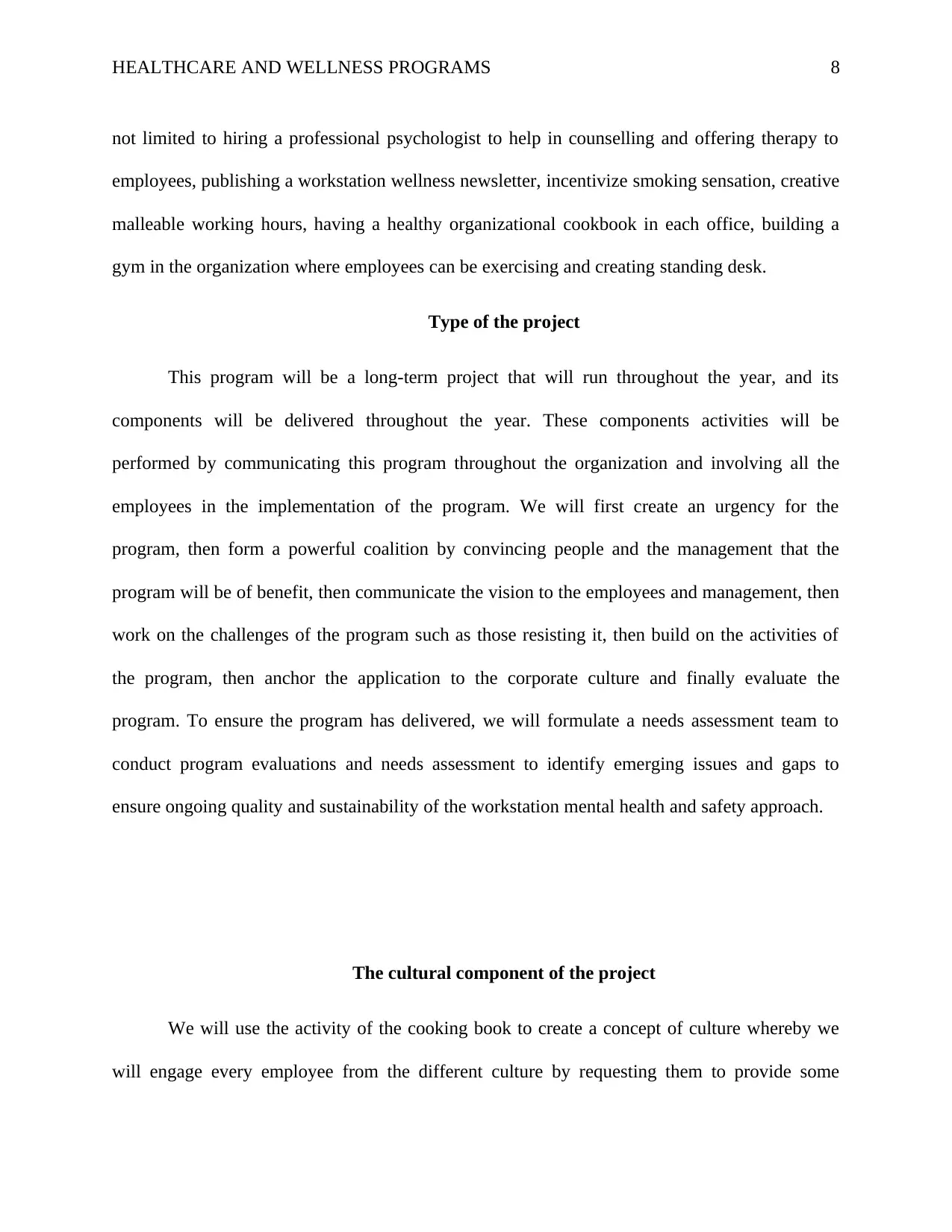
HEALTHCARE AND WELLNESS PROGRAMS 8
not limited to hiring a professional psychologist to help in counselling and offering therapy to
employees, publishing a workstation wellness newsletter, incentivize smoking sensation, creative
malleable working hours, having a healthy organizational cookbook in each office, building a
gym in the organization where employees can be exercising and creating standing desk.
Type of the project
This program will be a long-term project that will run throughout the year, and its
components will be delivered throughout the year. These components activities will be
performed by communicating this program throughout the organization and involving all the
employees in the implementation of the program. We will first create an urgency for the
program, then form a powerful coalition by convincing people and the management that the
program will be of benefit, then communicate the vision to the employees and management, then
work on the challenges of the program such as those resisting it, then build on the activities of
the program, then anchor the application to the corporate culture and finally evaluate the
program. To ensure the program has delivered, we will formulate a needs assessment team to
conduct program evaluations and needs assessment to identify emerging issues and gaps to
ensure ongoing quality and sustainability of the workstation mental health and safety approach.
The cultural component of the project
We will use the activity of the cooking book to create a concept of culture whereby we
will engage every employee from the different culture by requesting them to provide some
not limited to hiring a professional psychologist to help in counselling and offering therapy to
employees, publishing a workstation wellness newsletter, incentivize smoking sensation, creative
malleable working hours, having a healthy organizational cookbook in each office, building a
gym in the organization where employees can be exercising and creating standing desk.
Type of the project
This program will be a long-term project that will run throughout the year, and its
components will be delivered throughout the year. These components activities will be
performed by communicating this program throughout the organization and involving all the
employees in the implementation of the program. We will first create an urgency for the
program, then form a powerful coalition by convincing people and the management that the
program will be of benefit, then communicate the vision to the employees and management, then
work on the challenges of the program such as those resisting it, then build on the activities of
the program, then anchor the application to the corporate culture and finally evaluate the
program. To ensure the program has delivered, we will formulate a needs assessment team to
conduct program evaluations and needs assessment to identify emerging issues and gaps to
ensure ongoing quality and sustainability of the workstation mental health and safety approach.
The cultural component of the project
We will use the activity of the cooking book to create a concept of culture whereby we
will engage every employee from the different culture by requesting them to provide some
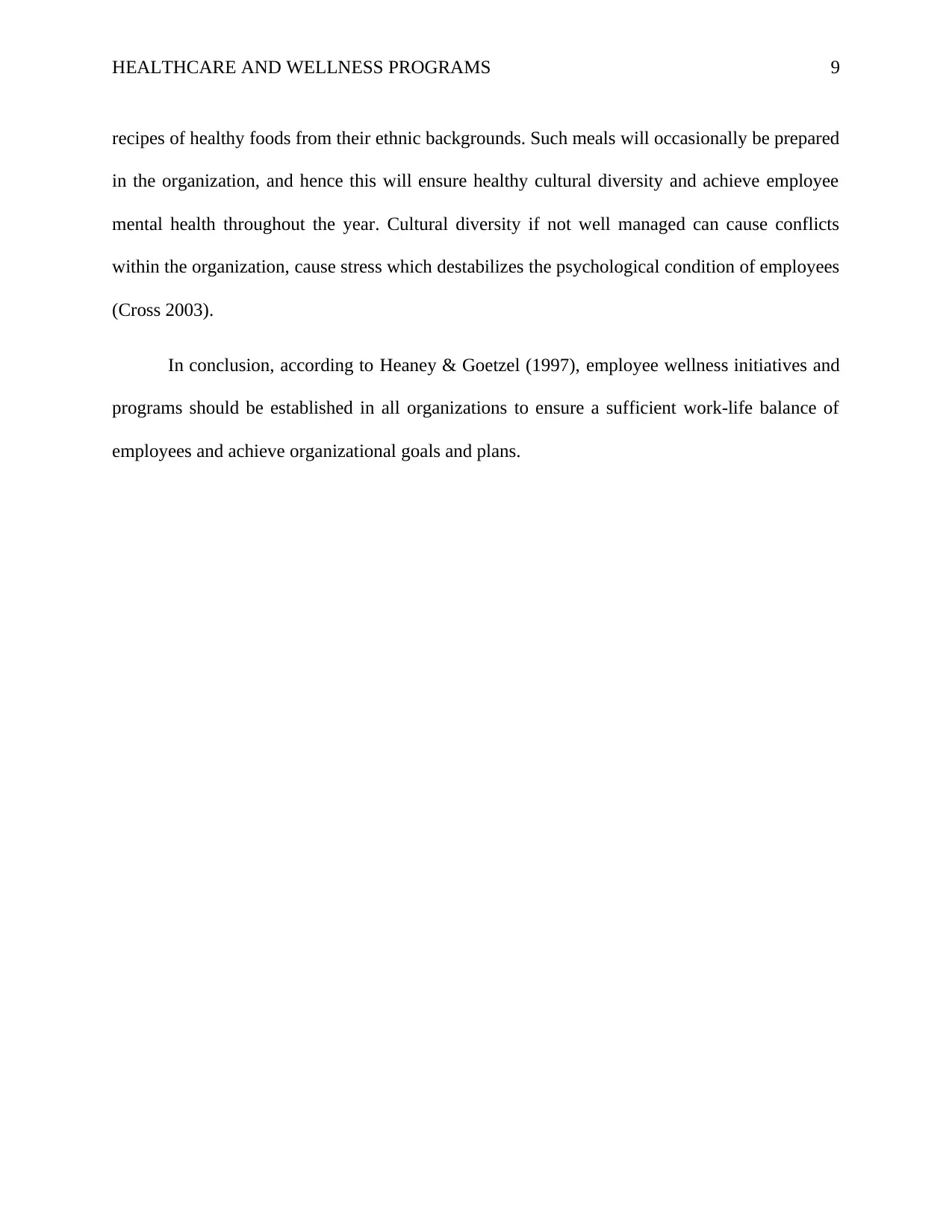
HEALTHCARE AND WELLNESS PROGRAMS 9
recipes of healthy foods from their ethnic backgrounds. Such meals will occasionally be prepared
in the organization, and hence this will ensure healthy cultural diversity and achieve employee
mental health throughout the year. Cultural diversity if not well managed can cause conflicts
within the organization, cause stress which destabilizes the psychological condition of employees
(Cross 2003).
In conclusion, according to Heaney & Goetzel (1997), employee wellness initiatives and
programs should be established in all organizations to ensure a sufficient work-life balance of
employees and achieve organizational goals and plans.
recipes of healthy foods from their ethnic backgrounds. Such meals will occasionally be prepared
in the organization, and hence this will ensure healthy cultural diversity and achieve employee
mental health throughout the year. Cultural diversity if not well managed can cause conflicts
within the organization, cause stress which destabilizes the psychological condition of employees
(Cross 2003).
In conclusion, according to Heaney & Goetzel (1997), employee wellness initiatives and
programs should be established in all organizations to ensure a sufficient work-life balance of
employees and achieve organizational goals and plans.
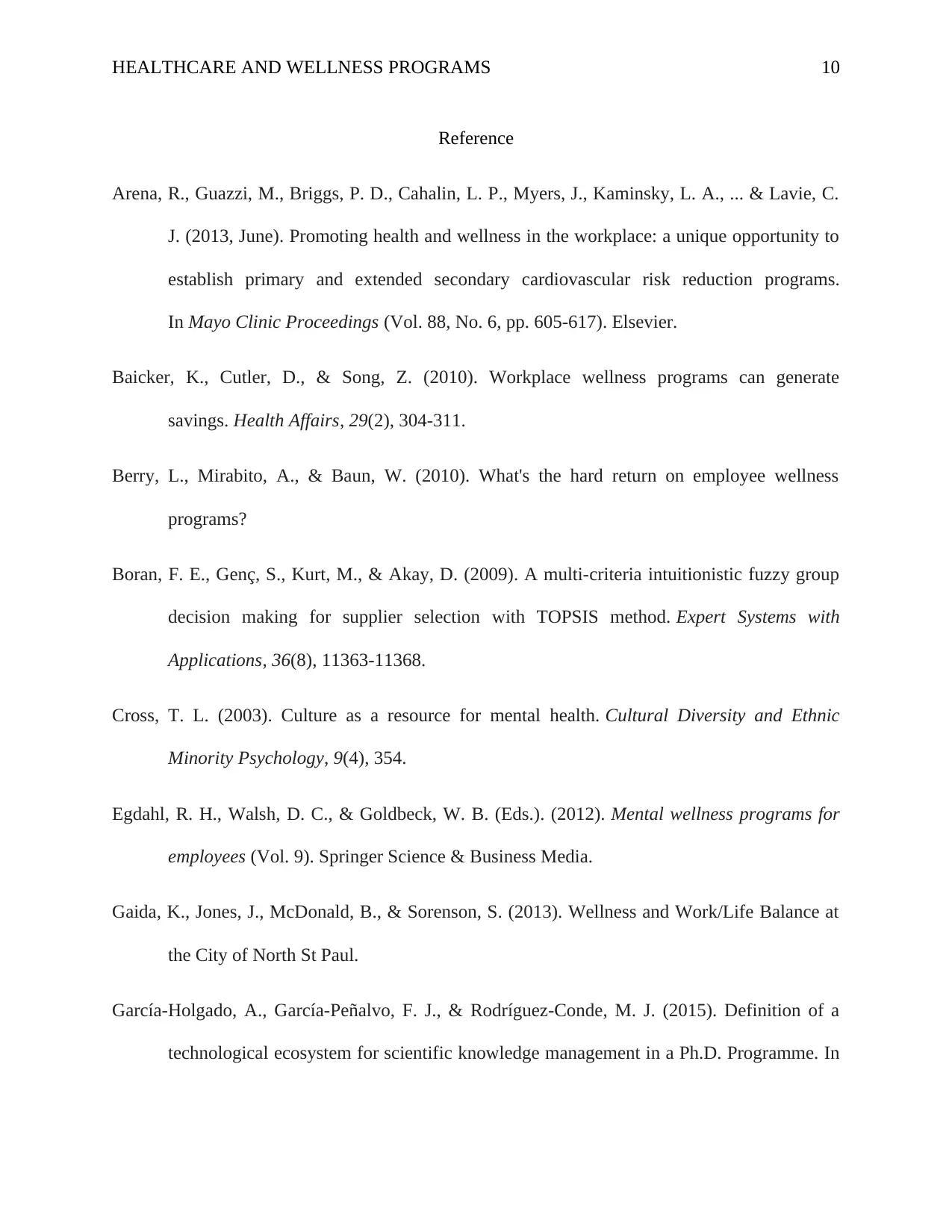
HEALTHCARE AND WELLNESS PROGRAMS 10
Reference
Arena, R., Guazzi, M., Briggs, P. D., Cahalin, L. P., Myers, J., Kaminsky, L. A., ... & Lavie, C.
J. (2013, June). Promoting health and wellness in the workplace: a unique opportunity to
establish primary and extended secondary cardiovascular risk reduction programs.
In Mayo Clinic Proceedings (Vol. 88, No. 6, pp. 605-617). Elsevier.
Baicker, K., Cutler, D., & Song, Z. (2010). Workplace wellness programs can generate
savings. Health Affairs, 29(2), 304-311.
Berry, L., Mirabito, A., & Baun, W. (2010). What's the hard return on employee wellness
programs?
Boran, F. E., Genç, S., Kurt, M., & Akay, D. (2009). A multi-criteria intuitionistic fuzzy group
decision making for supplier selection with TOPSIS method. Expert Systems with
Applications, 36(8), 11363-11368.
Cross, T. L. (2003). Culture as a resource for mental health. Cultural Diversity and Ethnic
Minority Psychology, 9(4), 354.
Egdahl, R. H., Walsh, D. C., & Goldbeck, W. B. (Eds.). (2012). Mental wellness programs for
employees (Vol. 9). Springer Science & Business Media.
Gaida, K., Jones, J., McDonald, B., & Sorenson, S. (2013). Wellness and Work/Life Balance at
the City of North St Paul.
García-Holgado, A., García-Peñalvo, F. J., & Rodríguez-Conde, M. J. (2015). Definition of a
technological ecosystem for scientific knowledge management in a Ph.D. Programme. In
Reference
Arena, R., Guazzi, M., Briggs, P. D., Cahalin, L. P., Myers, J., Kaminsky, L. A., ... & Lavie, C.
J. (2013, June). Promoting health and wellness in the workplace: a unique opportunity to
establish primary and extended secondary cardiovascular risk reduction programs.
In Mayo Clinic Proceedings (Vol. 88, No. 6, pp. 605-617). Elsevier.
Baicker, K., Cutler, D., & Song, Z. (2010). Workplace wellness programs can generate
savings. Health Affairs, 29(2), 304-311.
Berry, L., Mirabito, A., & Baun, W. (2010). What's the hard return on employee wellness
programs?
Boran, F. E., Genç, S., Kurt, M., & Akay, D. (2009). A multi-criteria intuitionistic fuzzy group
decision making for supplier selection with TOPSIS method. Expert Systems with
Applications, 36(8), 11363-11368.
Cross, T. L. (2003). Culture as a resource for mental health. Cultural Diversity and Ethnic
Minority Psychology, 9(4), 354.
Egdahl, R. H., Walsh, D. C., & Goldbeck, W. B. (Eds.). (2012). Mental wellness programs for
employees (Vol. 9). Springer Science & Business Media.
Gaida, K., Jones, J., McDonald, B., & Sorenson, S. (2013). Wellness and Work/Life Balance at
the City of North St Paul.
García-Holgado, A., García-Peñalvo, F. J., & Rodríguez-Conde, M. J. (2015). Definition of a
technological ecosystem for scientific knowledge management in a Ph.D. Programme. In
Secure Best Marks with AI Grader
Need help grading? Try our AI Grader for instant feedback on your assignments.
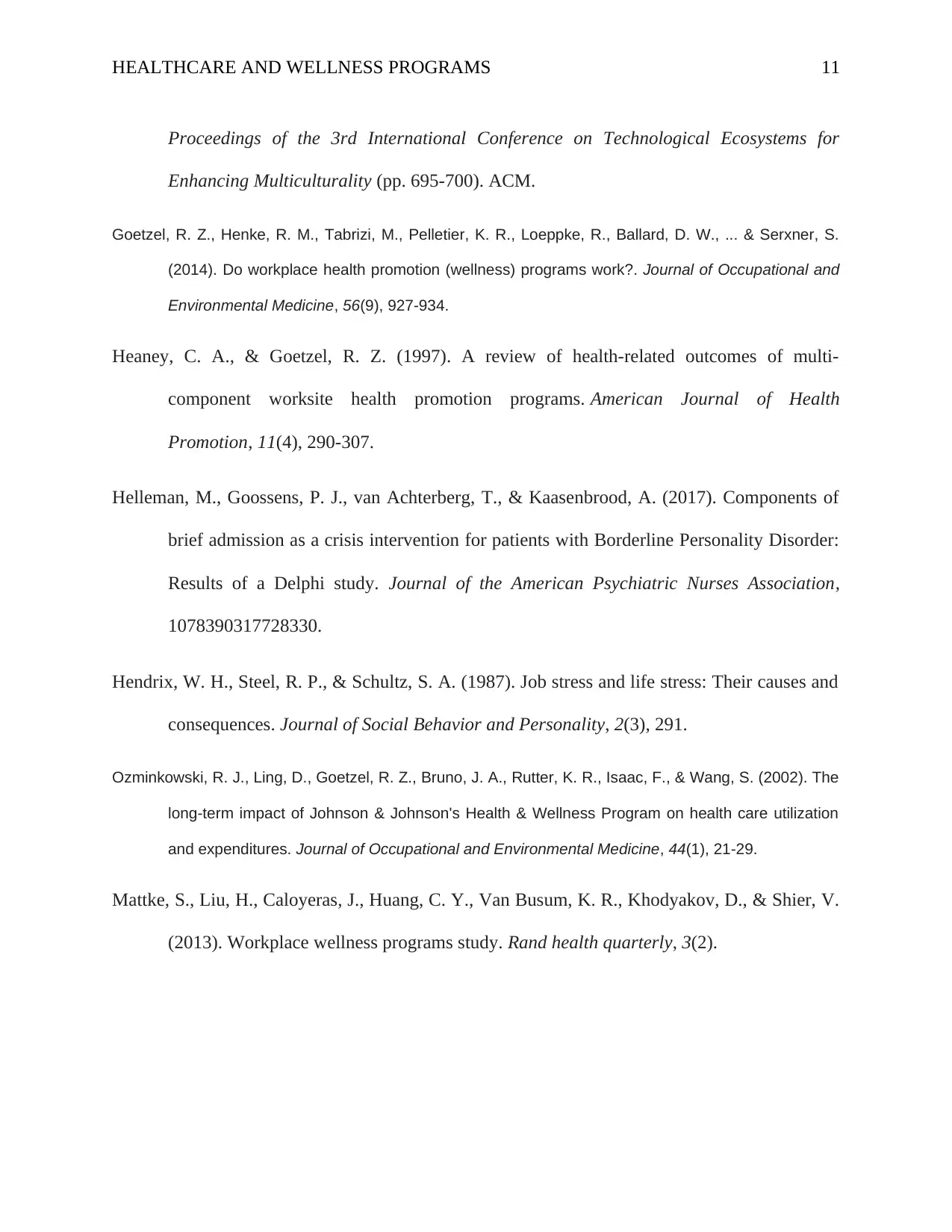
HEALTHCARE AND WELLNESS PROGRAMS 11
Proceedings of the 3rd International Conference on Technological Ecosystems for
Enhancing Multiculturality (pp. 695-700). ACM.
Goetzel, R. Z., Henke, R. M., Tabrizi, M., Pelletier, K. R., Loeppke, R., Ballard, D. W., ... & Serxner, S.
(2014). Do workplace health promotion (wellness) programs work?. Journal of Occupational and
Environmental Medicine, 56(9), 927-934.
Heaney, C. A., & Goetzel, R. Z. (1997). A review of health-related outcomes of multi-
component worksite health promotion programs. American Journal of Health
Promotion, 11(4), 290-307.
Helleman, M., Goossens, P. J., van Achterberg, T., & Kaasenbrood, A. (2017). Components of
brief admission as a crisis intervention for patients with Borderline Personality Disorder:
Results of a Delphi study. Journal of the American Psychiatric Nurses Association,
1078390317728330.
Hendrix, W. H., Steel, R. P., & Schultz, S. A. (1987). Job stress and life stress: Their causes and
consequences. Journal of Social Behavior and Personality, 2(3), 291.
Ozminkowski, R. J., Ling, D., Goetzel, R. Z., Bruno, J. A., Rutter, K. R., Isaac, F., & Wang, S. (2002). The
long-term impact of Johnson & Johnson's Health & Wellness Program on health care utilization
and expenditures. Journal of Occupational and Environmental Medicine, 44(1), 21-29.
Mattke, S., Liu, H., Caloyeras, J., Huang, C. Y., Van Busum, K. R., Khodyakov, D., & Shier, V.
(2013). Workplace wellness programs study. Rand health quarterly, 3(2).
Proceedings of the 3rd International Conference on Technological Ecosystems for
Enhancing Multiculturality (pp. 695-700). ACM.
Goetzel, R. Z., Henke, R. M., Tabrizi, M., Pelletier, K. R., Loeppke, R., Ballard, D. W., ... & Serxner, S.
(2014). Do workplace health promotion (wellness) programs work?. Journal of Occupational and
Environmental Medicine, 56(9), 927-934.
Heaney, C. A., & Goetzel, R. Z. (1997). A review of health-related outcomes of multi-
component worksite health promotion programs. American Journal of Health
Promotion, 11(4), 290-307.
Helleman, M., Goossens, P. J., van Achterberg, T., & Kaasenbrood, A. (2017). Components of
brief admission as a crisis intervention for patients with Borderline Personality Disorder:
Results of a Delphi study. Journal of the American Psychiatric Nurses Association,
1078390317728330.
Hendrix, W. H., Steel, R. P., & Schultz, S. A. (1987). Job stress and life stress: Their causes and
consequences. Journal of Social Behavior and Personality, 2(3), 291.
Ozminkowski, R. J., Ling, D., Goetzel, R. Z., Bruno, J. A., Rutter, K. R., Isaac, F., & Wang, S. (2002). The
long-term impact of Johnson & Johnson's Health & Wellness Program on health care utilization
and expenditures. Journal of Occupational and Environmental Medicine, 44(1), 21-29.
Mattke, S., Liu, H., Caloyeras, J., Huang, C. Y., Van Busum, K. R., Khodyakov, D., & Shier, V.
(2013). Workplace wellness programs study. Rand health quarterly, 3(2).
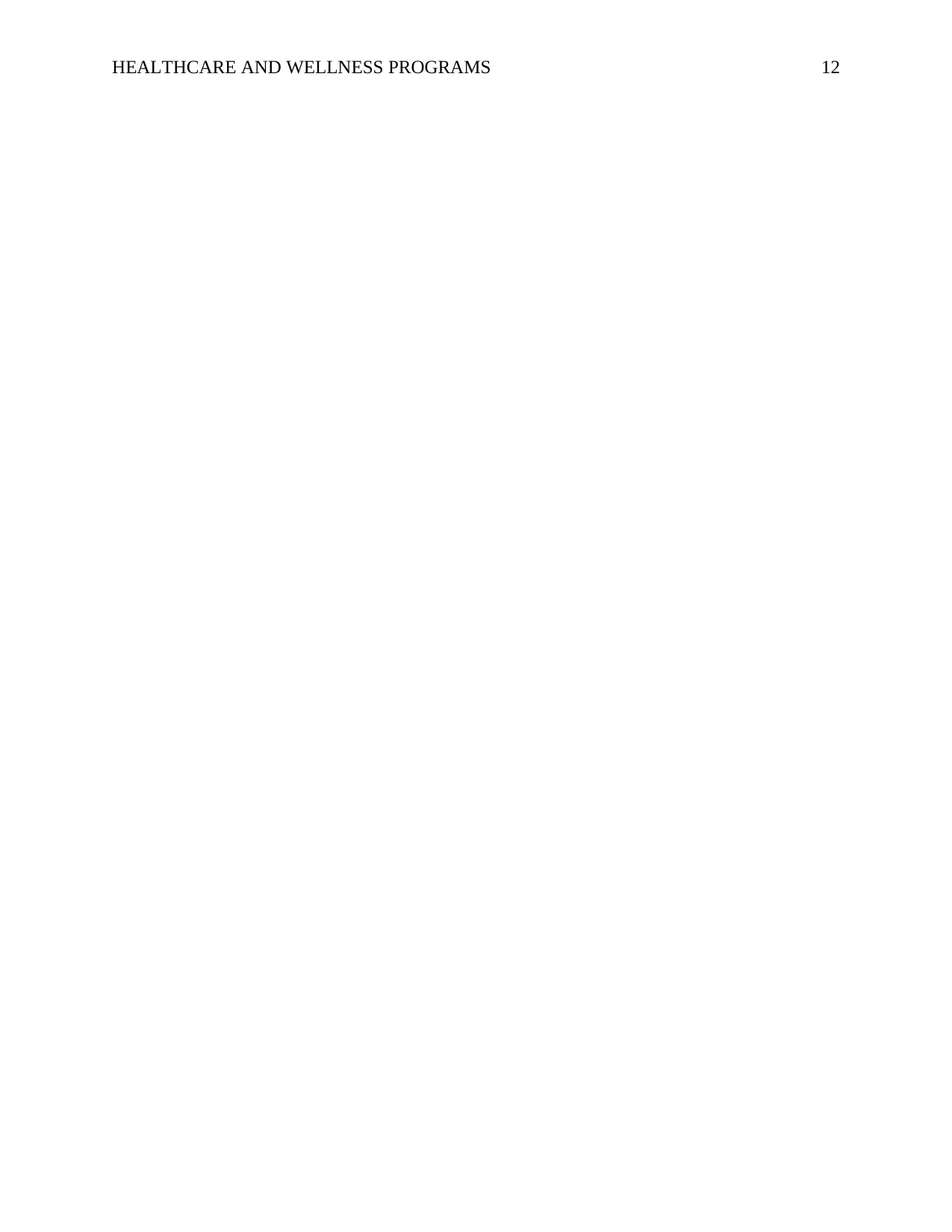
HEALTHCARE AND WELLNESS PROGRAMS 12
1 out of 12
Related Documents
Your All-in-One AI-Powered Toolkit for Academic Success.
+13062052269
info@desklib.com
Available 24*7 on WhatsApp / Email
![[object Object]](/_next/static/media/star-bottom.7253800d.svg)
Unlock your academic potential
© 2024 | Zucol Services PVT LTD | All rights reserved.




